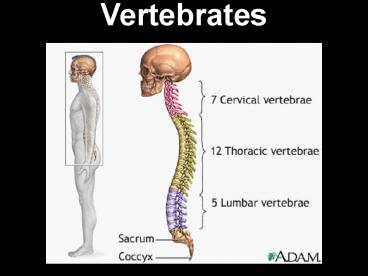Vertebrates - PowerPoint PPT Presentation
1 / 48
Title:
Vertebrates
Description:
Vertebrates Lungfishes Classes of Chordates Tetrapods Classes of Tetrapods Amphibians Urodela ( tailed ones ) Salamanders Anura ( tailless ones ) Frogs and ... – PowerPoint PPT presentation
Number of Views:252
Avg rating:3.0/5.0
Title: Vertebrates
1
Vertebrates
2
- Which of these is most closely related to you?
3
- Which of these is most closely related to you?
4
Vertebrates
- Echinoderms and Chordates are the only two phyla
of deuterostomes.
5
Chordata fish, amphibians, reptiles, birds,
mammals
- Deuterostome coelomates
- Notochord serves as axis of body
- Dorsal, hollow nerve cord
- Tails. Human coccyx is vestigial tail.
- Birds mammals homeotherms (constant body
temperature) - All others are poikilotherms (cold-blooded)
though some reptiles are endothermic.
6
Mammalsclass
- Nurse their young with milk
- Have hair or fur made of keratin
- Homeotherms
- Placental develops in womb
- Marsupial born early, develops in pouch
- Monotreme egg-laying (duck-billed platypus and
spiny anteater).
7
Primatesorder
- Hands with opposable thumbs
- Claws have become nails
- Eyes are in front and close together for
binocular vision - Nurture their young for a long time.
8
Chordate Characteristics
9
Chordate Characteristics
Notochord
- A flexible rod between the nerve cord and the
digestive tube - All chordates have this as embryos
- Most develop later into complex, jointed
skeleton.
10
Chordate Characteristics
Dorsal, hollow nerve cord
- Develops from a plate of ectoderm that rolls into
a tube - Unique to chordates. (Other phyla have solid,
ventral nerve cords) - Develops into central nervous system, spinal
cord, and brain.
11
Chordate Characteristics
Pharyngeal slits or clefts
- Just posterior to the mouth
- Used for suspension feeding and gas exchange
(gills) - In land animals, they develop into parts of the
ear.
12
Chordate Characteristics
Muscular, post-anal tail
- Lost during embryonic development in many species
- Provides propulsion for many aquatic species.
13
Classes of Chordates
14
Classes of Chordates
Tunicates
15
Classes of Chordates
Tunicates
16
Classes of Chordates
Tunicates
17
Classes of Chordates
Tunicates
18
Classes of Chordates
Lancelets
19
Classes of Chordates
Lancelets
20
Classes of Chordates
Hagfish
- Craniate (has brain and skull)
- No jaws
- No vertebrae
21
Classes of Chordates
Hagfish
22
Classes of Chordates
Hagfish
23
Classes of Chordates
Hagfish
24
Classes of Chordates
Lamprey
- Vertebrate (has backbone)
- Still no jaws
25
Classes of Chordates
Lamprey
26
Classes of Chordates
Lamprey
27
Classes of Chordates
Lamprey
28
Classes of Chordates
Sharks and Rays
- Gnathostomes (jaw-mouths)
- Bones have some mineralization but are still
mostly cartilage - Acute senses (lateral line, nostrils,
black-and-white vision) - Oviparous, ovoviviparous, or viviparous.
29
Classes of Chordates
Sharks and Rays
30
Classes of Chordates
Sharks and Rays
31
Classes of Chordates
Sharks and Rays
32
Classes of Chordates
Ray-Finned Fishes
33
Classes of Chordates
Lobe-Finned Fishes
34
Classes of Chordates
Lungfishes
35
Tetrapods
36
Classes of Tetrapods
Amphibians Urodela (tailed ones) Salamanders
Anura (tailless ones) Frogs and toads Apoda
(legless ones) Caecilians
37
Classes of Tetrapods
- Amphibians
- Adaptations
- Camouflage
- Poison
- Metamorphosis / paedomorphosis
- Complex social behavior
- Eggs lack shells, dehydrate quickly
- Gas exchange through moist skin
38
Amniotes
39
Amniotes
- Amniotic egg may be laid on land.
- Contains extra-embryonic membrane
- May be calcified (birds) or leathery (reptiles)
or may implant in the uterus (mammals)
40
Phylogeny of Amniotes
Synapsidia
Anapsidia
Ancestral amniote
Diapsidia
41
Phylogeny of Amniotes
Mammals Turtles Lizards Snakes Crocodiles
Dinosaurs Birds
Synapsidia
Anapsidia
Ancestral amniote
Diapsidia
42
Phylogeny of Amniotes
Mammals Turtles Lizards Snakes Crocodiles
Dinosaurs Birds
Synapsidia
Anapsidia
Ancestral amniote
Diapsidia
43
Reptiles
- Adaptations
- Keratinized skin
- Lungs
- Leathery shells on eggs
- Ectotherms.
44
Birds began as feathered reptiles
- Adaptations
- Feathers
- Honeycombed bones
- Missing some organs
- Gizzard instead of teeth
- Endothermic
- Four-chambered heart
- Good vision
- Relatively large brains.
45
Mammals diversified in the wake of the Cretaceous
extinctions
- Adaptations
- Mammary glands
- Hair
- Four-chambered heart
- Endothermic
- Placenta / live birth
- Large brains
- Differentiated teeth.
46
Primates and Human Evolution
- Adaptations
- Brain size
- Jaw shape
- Bipedal posture
- Size difference between sexes
- Long-term pair bonding
- Long-term infant dependency.
47
Multiregional Hypothesis
African European Asian Austalasian
Homo erectus In Africa
interbreeding 1-2 million years ago
48
Replacement Hypothesis
African European Asian Austalasian
Homo erectus In Africa
100,000 years ago 1-2 million years ago































